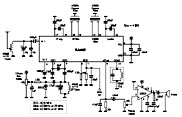|
01 - 46.610 / 49.670 |
06 - 46.770 / 49.830 |
02 - 46.630 / 49.845 |
07 - 46.830 / 49.890 |
03 - 46.670 / 49.860 |
08 - 46.870 / 49.930 |
04 - 46.710 / 49.770 |
09 - 46.930 / 49.990 |
05 - 46.730 / 49.875 |
10 - 46.970 / 49.970 |
|
|
|
01A - 49.930 / 1.695 |
06A - 49.830 / 1.705 |
13A - 49.860 / 1.765 |
19A - 49.875 / 1.795 |
25A - 49.890 / 1.825 |
27A - 49.845 / 1.735 |
|
|
|
|
| 01 - 43.720 / 48.760 |
14 - 44.460 / 49.460 |
| 02 - 43.740 / 48.840 |
15 - 44.480 / 49.500 |
| 03 - 43.820 / 48.860 |
16 - 46.610 / 49.670 |
| 04 - 43.840 / 48.920 |
17 - 46.630 / 49.845 |
| 05 - 43.920 / 49.020 |
18 - 46.670 / 49.860 |
| 06 - 43.960 / 49.080 |
19 - 46.710 / 49.770 |
| 07 - 44.120 / 49.100 |
20 - 46.730 / 49.875 |
| 08 - 44.160 / 49.160 |
21 - 46.770 / 49.830 |
| 09 - 44.180 / 49.200 |
22 - 46.830 / 49.890 |
| 10 - 44.200 / 49.240 |
23 - 46.870 / 49.930 |
| 11 - 44.320 / 49.280 |
24 - 46.930 / 49.990 |
| 12 - 44.360 / 49.360 |
25 - 46.970 / 49.970 |
| 13 - 44.400 / 49.400 |
|
|
|
|
Six-channel systems are
pre-1984, and are all but obsolete. They differ from the other systems in that they
use radio spectrum just above the AM radio band for the base transmit frequency. An
AM radio slighly detuned or shortwave receiver is all it takes to capture a signal from
one of these, and their transmit range can be quite good.
Ten-channel systems became available around 1985 and replaced the AM mode used in the base
with FM. They offer better clarity, less noise, and a range of about 1000 feet or
so, although under ideal conditions the signal can go much farther.
Twenty-five channel systems came out around 1995-1996 after the FCC opened up additional
frequency space to relieve the overcrowed ten-channel systems. They keep the
original channels from the ten-channel system (now setup as channels 16-25), and added
fifteen new ones using the 43, 44 and 48 Mhz bands. They offer the same basic range,
with the only difference being the expanded selection of channels.
Because cordless phones operate on the lower end of the VHF spectrum, those rubber duckie
antennas that ship with most handheld scanners are usually not enough to tune this band
(unless you are right nextdoor to the base unit). A telescoping antenna is your best
bet (Radio Shack #20-006 works fine). Hobbyists on a budget - check the portable
homebrew antenna on the main scanner page.
For the real dedicated listener, consider purchasing good quality low-band antenna, such
as the Grove Scanner Beam, the
Channel Master 5094A, or the new 46 MHz antenna from Cellular Security Group.
It is the base frequency that needs to be tuned in to hear both sides of a
conversation.
The handset frequency only provides audio coming from the handset itself, but can
be very useful in helping you identify the source house that the call originates from if
you own a handheld scanner. Once you have locked onto a call on the base frequency,
punch up its handset counterpart. If the signal is weak, the call is probably not
real close. By walking the vicinity, the signal should get clearer as you near the
handset's signal. At this point, you either switch to the rubber duckie antenna, or
completely remove all antennas and continue walking. The signal will probably get
snowy again, but will clear up when you are right on top of the source house. Please
note: many cordless phones will scan all channels for the least amount of interference,
and then select one before giving dialtone or answering a call. If you pinpoint a
specific frequency as coming from a particular neighbor, odds are that the frequency will
be different next time they pick up the phone.
Brief buzzsaw or chopping noises heard on the base frequencies usually indicates that an
incoming call is being received (the base is ringing the handset). Stay on this
channel - you should hear someone answer shortly.
Some 46/49 Mhz models use voice-scrambling to maintain the privacy of the individual.
Cordless phones advertising 320,000 security codes to prevent unauthorized listening mean
nothing to a scanner. These codes only prevent other cordless phones from listening
in - even a baby monitor receiver can tune in these channels in most cases.
|
 Cordless phone BUG
Cordless phone BUG